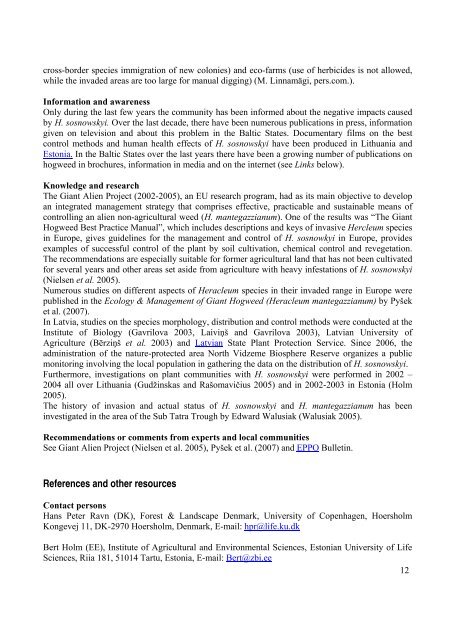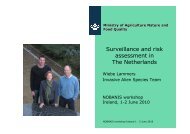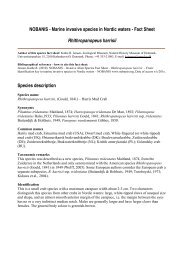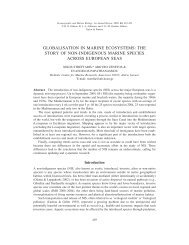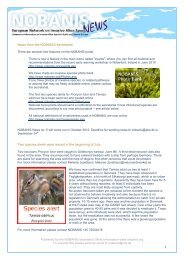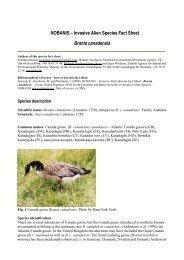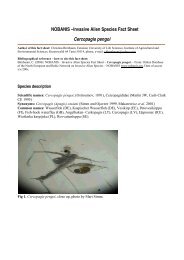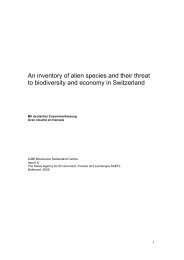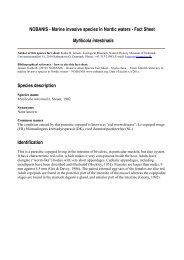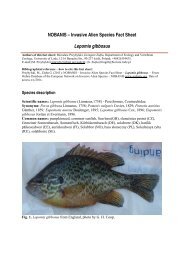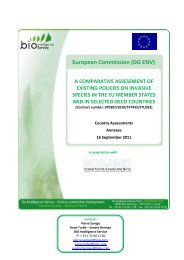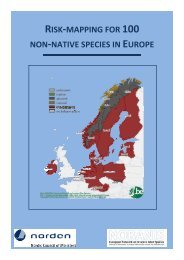NOBANIS – Invasive Alien Species Fact Sheet Heracleum sosnowskyi
NOBANIS – Invasive Alien Species Fact Sheet Heracleum sosnowskyi
NOBANIS – Invasive Alien Species Fact Sheet Heracleum sosnowskyi
You also want an ePaper? Increase the reach of your titles
YUMPU automatically turns print PDFs into web optimized ePapers that Google loves.
cross-border species immigration of new colonies) and eco-farms (use of herbicides is not allowed,<br />
while the invaded areas are too large for manual digging) (M. Linnamägi, pers.com.).<br />
Information and awareness<br />
Only during the last few years the community has been informed about the negative impacts caused<br />
by H. <strong>sosnowskyi</strong>. Over the last decade, there have been numerous publications in press, information<br />
given on television and about this problem in the Baltic States. Documentary films on the best<br />
control methods and human health effects of H. <strong>sosnowskyi</strong> have been produced in Lithuania and<br />
Estonia. In the Baltic States over the last years there have been a growing number of publications on<br />
hogweed in brochures, information in media and on the internet (see Links below).<br />
Knowledge and research<br />
The Giant <strong>Alien</strong> Project (2002-2005), an EU research program, had as its main objective to develop<br />
an integrated management strategy that comprises effective, practicable and sustainable means of<br />
controlling an alien non-agricultural weed (H. mantegazzianum). One of the results was “The Giant<br />
Hogweed Best Practice Manual”, which includes descriptions and keys of invasive Hercleum species<br />
in Europe, gives guidelines for the management and control of H. sosnowkyi in Europe, provides<br />
examples of successful control of the plant by soil cultivation, chemical control and revegetation.<br />
The recommendations are especially suitable for former agricultural land that has not been cultivated<br />
for several years and other areas set aside from agriculture with heavy infestations of H. <strong>sosnowskyi</strong><br />
(Nielsen et al. 2005).<br />
Numerous studies on different aspects of <strong>Heracleum</strong> species in their invaded range in Europe were<br />
published in the Ecology & Management of Giant Hogweed (<strong>Heracleum</strong> mantegazzianum) by Pyšek<br />
et al. (2007).<br />
In Latvia, studies on the species morphology, distribution and control methods were conducted at the<br />
Institute of Biology (Gavrilova 2003, Laiviņš and Gavrilova 2003), Latvian University of<br />
Agriculture (Bērziņš et al. 2003) and Latvian State Plant Protection Service. Since 2006, the<br />
administration of the nature-protected area North Vidzeme Biosphere Reserve organizes a public<br />
monitoring involving the local population in gathering the data on the distribution of H. <strong>sosnowskyi</strong>.<br />
Furthermore, investigations on plant communities with H. <strong>sosnowskyi</strong> were performed in 2002 <strong>–</strong><br />
2004 all over Lithuania (Gudžinskas and Rašomavičius 2005) and in 2002-2003 in Estonia (Holm<br />
2005).<br />
The history of invasion and actual status of H. <strong>sosnowskyi</strong> and H. mantegazzianum has been<br />
investigated in the area of the Sub Tatra Trough by Edward Walusiak (Walusiak 2005).<br />
Recommendations or comments from experts and local communities<br />
See Giant <strong>Alien</strong> Project (Nielsen et al. 2005), Pyšek et al. (2007) and EPPO Bulletin.<br />
References and other resources<br />
Contact persons<br />
Hans Peter Ravn (DK), Forest & Landscape Denmark, University of Copenhagen, Hoersholm<br />
Kongevej 11, DK-2970 Hoersholm, Denmark, E-mail: hpr@life.ku.dk<br />
Bert Holm (EE), Institute of Agricultural and Environmental Sciences, Estonian University of Life<br />
Sciences, Riia 181, 51014 Tartu, Estonia, E-mail: Bert@zbi.ee<br />
12


